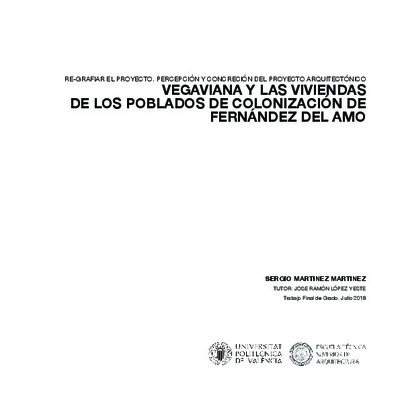|
Resumen:
|
[ES] En la Posguerra española, mientras se intentaba imponer una estilo nacional que representase los valores del nuevo Régimen, surgió una arquitectura moderna inspirada en la arquitectura popular superando las dificultades ...[+]
[ES] En la Posguerra española, mientras se intentaba imponer una estilo nacional que representase los valores del nuevo Régimen, surgió una arquitectura moderna inspirada en la arquitectura popular superando las dificultades del momento. Dentro del Instituto Nacional de Colonización, que tuvo la tarea de colonizar nuevas regiones convertidas en tierras de regadío, nació una arquitectura verdadera en la que destaca Fernández del Amo.
En Vegaviana (Cáceres) evidenció su entendimiento de la arquitectura tradicional, donde mostró la esencia de la arquitectura anónima que prolifera en el ambiente rural: verdadero funcionalismo, escala, relación con el paisaje, supresión de lo superfluo... Aparece así una arquitectura abstracta y culta, a la vez que popular, construida con los materiales y técnicas del lugar que dotan al conjunto de gran belleza.
Las viviendas de Vegaviana se construyeron ciñéndose a una normativa de estándares de calidad conforme a unos modos de vida y un ámbito que poco tienen que ver con los actuales. No es posible equiparar aquellas normativas con las actuales por atender a estilos de vida distintos. Las necesidades del hombre, eje central de la ocupación arquitectónica, van evolucionando, y deben ser el fundamento de cualquier cambio normativo.
[-]
[EN] During the Spanish PostWar period, while it was trying to impose a national style that represents the values of the new regime, it arose a modern architecture inspired by popular architecture overcoming the difficulties ...[+]
[EN] During the Spanish PostWar period, while it was trying to impose a national style that represents the values of the new regime, it arose a modern architecture inspired by popular architecture overcoming the difficulties of the moment. Within the National Institute of Colonization, that had the task of colonizing new regions converted into irrigated land, a true architecture was born in which Fernandez del Amo stands out.
In Vegaviana (Cáceres) he showed his understanding of traditional architecture, where he displayed the essence of anonymous architecture that proliferates in the rural environment: true functionalism, scale, relationship with the landscape, suppression of the superfluous¿ It thus appears an abstract and cultured architecture, as well as popular, built with the materials and techniques of the place that give the whole great beauty.
Vegaviana dwellings were built adhering to a norm of quality standards according to some lifestyles and a scope that have little to do with current. It is not possible to equate those regulations with the current ones because they address different lifestyles. The needs of man, the central axis of architectural occupation, are evolving, and should be the foundation of any regulatory change.
[-]
|







